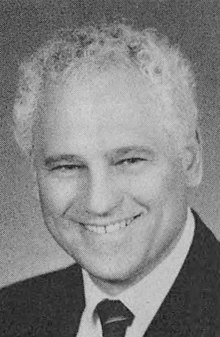Neil Goldschmidt | |
|---|---|
 Goldschmidt in 1986 | |
| 33rd Governor of Oregon | |
| In office January 12, 1987 – January 14, 1991 | |
| Preceded by | Victor Atiyeh |
| Succeeded by | Barbara Roberts |
| 6th United States Secretary of Transportation | |
| In office September 24, 1979 – January 20, 1981 | |
| President | Jimmy Carter |
| Preceded by | Brock Adams |
| Succeeded by | Drew Lewis |
| 45th Mayor of Portland | |
| In office January 2, 1973 – August 15, 1979 | |
| Preceded by | Terry Schrunk |
| Succeeded by | Connie McCready |
| Personal details | |
| Born | June 16, 1940 Eugene, Oregon, U.S. |
| Died | June 12, 2024 (aged 83) Portland, Oregon, U.S. |
| Political party | Democratic |
| Spouses | Margaret Wood
(m. 1965; div. 1990)Diana Snowden (m. 1994) |
| Children | 4 |
| Education | University of Oregon (BA) University of California, Berkeley (JD) |
Neil Edward Goldschmidt (June 16, 1940 – June 12, 2024) was an American businessman and Democratic politician from the state of Oregon who held local, state, and federal offices over three decades. After serving as mayor of Portland, Oregon, the United States Secretary of Transportation under President Jimmy Carter and governor of Oregon, Goldschmidt was at one time considered the most powerful and influential figure in Oregon's politics. In 2004, Goldschmidt's career and legacy were irreparably damaged by revelations of the ongoing sexual abuse of a young teenage girl beginning in 1973, during his first term as mayor of Portland.[1][2][3]
Goldschmidt was elected to the Portland City Council in 1970 and then as mayor of Portland in 1972, becoming, at the age of 32, the youngest mayor of any major American city. He promoted the revitalization of Downtown Portland and was influential on Portland-area transportation policy, particularly with the scrapping of the controversial Mount Hood Freeway and the establishment of the MAX Light Rail system. He was appointed U.S. Secretary of Transportation by President Jimmy Carter in 1979; in that capacity he worked to revive the ailing automobile industry and to deregulate several industries. He served until the end of Carter's presidency in 1981 and then served as a senior executive with Nike for several years.
In 1986, Goldschmidt was elected the 33rd governor of Oregon, serving a single term. He faced significant challenges, particularly a rising anti-tax movement (leading to Measure 5 in 1990) and a doubling of the state's prison population. He worked across party lines to reduce regulation and to repair the state's infrastructure. His reforms to the State Accident Insurance Fund (SAIF), a state-chartered worker's compensation insurance company were heralded at the time, but drew strong criticism in later years.
Despite an almost certain re-election as governor, Goldschmidt did not seek a second term, becoming an influential and controversial lobbyist. Over the next dozen years or so, he was criticized by editorial boards and Oregonians for several of the causes he supported, including backing the forestry corporation Weyerhaeuser in its hostile takeover of Oregon's Willamette Industries and his advocacy for a private investment firm in its attempt to take over utility company Portland General Electric. In 2003, Governor Ted Kulongoski appointed Goldschmidt to the Oregon Board of Higher Education, a position he resigned after admitting he had sexually abused a minor girl 30 years earlier.
- ^ Rosen, Jill (August–September 2004). "The Story Behind the Story". American Journalism Review. Archived from the original on November 11, 2013. Retrieved November 22, 2006.
- ^ Cite error: The named reference
wweekjaquisswas invoked but never defined (see the help page). - ^ Howard Kurtz (May 13, 2004). "Another Abuse Story". The Washington Post. Archived from the original on October 22, 2016. Retrieved September 6, 2017.